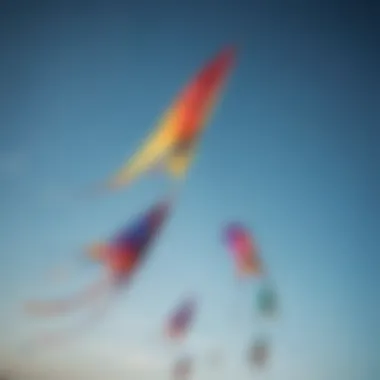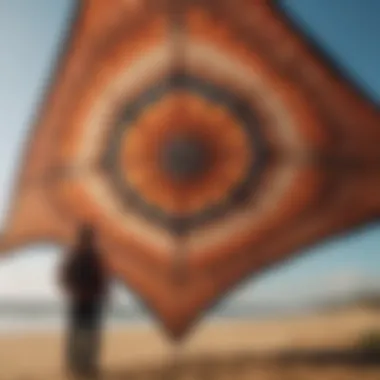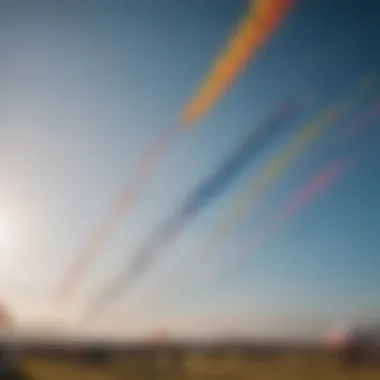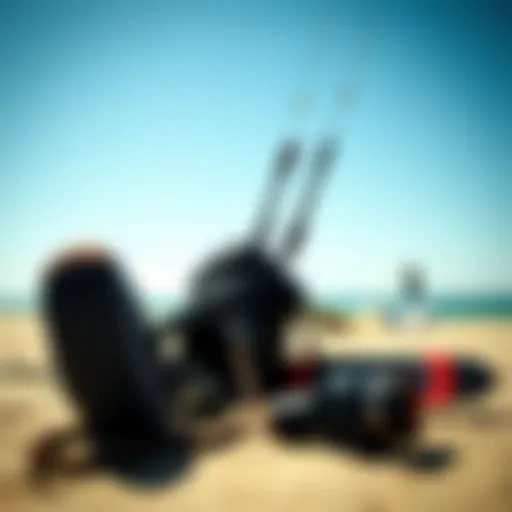Exploring the Fascinating World of Huge Kites


Intro
Kites have always stirred curiosity, capturing imaginations and bringing people together under a colorful sky. Among the diverse kinds of kites, huge kites stand tall—literally and figuratively. Not merely toys, these oversized constructs have a rich tapestry of history woven with cultural significance and evolving designs. From traditional festivals celebrating the changing of seasons to modern-day sporting events, huge kites embody both artistry and innovation.
Understanding the world of huge kites offers insights into their practical applications—from competitive kiteboarding to community gatherings where artistry takes flight. In this piece, we'll unravel the many layers that define these remarkable flying machines. Whether you’re an avid kiteboarding enthusiast or a curious adventurer exploring a new hobby, this journey dives into the intricate details of huge kites, ensuring readers leave with a broader appreciation for this captivating pursuit.
Gear Insights
In the realm of kite flying, the right gear makes all the difference. Choosing the proper equipment not only enhances the experience but also ensures safety amid the exhilarating rush.
Latest Gear Reviews
Let's take a closer look at the newest arrivals in the kite gear market:
- HQ Symphony Beach Fighter 2.0: Known for its exceptional stability and easy handling, suitable for beginners and experienced flyers alike.
- Peter Lynn Uniburro 4.0: A massive single-line kite that dazzles at festivals. It’s durable, colorful, and turns heads effortlessly.
- Ozone Wasp V1: A revolutionary wing that has taken the kiteboarding scene by storm, offering unmatched inflate-and-deploy convenience.
Each piece of gear is tested to ensure it meets performance standards, giving you not only reliability but also a splash of style.
Essential Gear for Beginners
Starting with huge kites? No worries! Here are a few essentials:
- Kite: Opt for a soft-kite design which is easy to handle and forgiving during mishaps.
- Line: A sturdy line is necessary; choose about 100 feet for initial flights.
- Winder: A winder helps keep your lines organized and tangle-free.
- Safety Harness: Especially crucial for those venturing into kiteboarding.
Equipping yourself with the right tools fosters a positive kite-flying experience and empowers you to enjoy this exhilarating hobby.
Techniques and Tips
As with any sport, excellence comes with practice. With huge kites, mastering the techniques can elevate the whole adventure.
Advanced Tricks and Techniques
When you’re ready to take it up a notch, consider these advanced maneuvers:
- The Box Loop: A combination of loops that creates a cube-like flight pattern.
- Fast Spins: Quick rotations require precise control and a deep understanding of your kite's movement.
- Tricks with Team Flying: Coordinating with fellow flyers can create a stunning aerial display.
These tricks not only impress but also sharpen your skills beyond the basics.
Safety Practices for Kiteboarders
Remember, fun shouldn't come at the cost of safety:
- Pre-Flight Check: Always inspect your gear before heading out.
- Know Your Environment: Be informed of wind conditions and surroundings.
- Follow Local Regulations: Every area has its own kiteboarding rules—familiarize yourself with them.
- Wear Protective Gear: Helmets and impact vests can significantly reduce injury risk.
By adhering to safety practices, you can focus on the thrill of flying while ensuring a secure environment for yourself and others.
As we delve deeper into the cultural significance and artistic displays involved in the world of huge kites, one thing becomes clear: these skyward marvels are more than just a pastime; they represent an extraordinary blend of history, technology, and creativity. Let's explore more!
Prelims to Huge Kites
Huge kites hold a unique place in both the realm of recreation and the tapestry of human culture. They are not merely colorful fabric stretched across a framework; they are emblematic of creativity, engineering skill, and community spirit. This section delves into what exactly makes these oversized flyers special, as well as their historical significance.
Definition and Characteristics
Huge kites are characterized, first and foremost, by their sheer size and dynamic designs. While a traditional kite might be a few feet wide, huge kites can span several meters, creating spectacular displays against the backdrop of the sky. These kites come in various shapes and sizes, often resembling mythical creatures, popular characters, or even geometric patterns.
Their construction typically involves a robust fabric, like ripstop nylon or polyester, which can withstand strong winds while remaining light enough to float in the air. The framework generally incorporates flexible materials such as fiberglass or carbon fiber, allowing the kites to maintain their unique forms even in gusty conditions. Additionally, many huge kites feature intricate artwork or vibrant colors, making them not just flying objects, but works of art that capture the imagination.
Historical Context
The history of kites is rich and diverse, with roots tracing back thousands of years to ancient civilizations. In China, for example, some of the oldest references include the military use of kites for sending messages or signaling tactics. Over time, especially during the Tang and Song dynasties, kites evolved into recreational devices, becoming symbols of festivals and cultural events.
As we journey across the globe, we see that each culture has adapted their designs and uses; for example, in India, kite flying is an integral part of Makar Sankranti, celebrated with great enthusiasm. Similarly, the colorful and enormous kites featured in the annual International Kite Festival in Gujarat bring together enthusiasts from around the world.
"Kite flying transcends borders, uniting people of all ages and backgrounds in shared joy and creativity."
Overall, huge kites serve as both a testament to human ingenuity and a reminder of our connection to the skies. As we explore the various aspects of these fascinating constructs in the following sections, we will uncover how innovative designs, cultural meanings, and community festivals make huge kites a significant element in both leisure and tradition.
The Design Aspects of Huge Kites
The design of huge kites plays a pivotal role in determining their functionality and aesthetic appeal. Understanding the intricacies of their construction can enhance both performance in the air and the visual experience on the ground. This segment dives into the materials and aerodynamics that shape the world of huge kites, illuminating their significance in crafting these magnificent aerial wonders.
Materials Used


Fabric Choices
When it comes to fabric for huge kites, the choices can be as diverse as the kites themselves. Different fabrics offer a range of benefits depending on how the kite will be used.
One prevalent choice is ripstop nylon. This material is known for its durability and lightweight properties, making it ideal for kites that endure strong winds. The unique construction of ripstop fabric prevents tearing and helps maintain the kite's shape even in turbulent conditions. Its breathability allows for better airflow, crucial for lift and maneuverability, setting it apart from heavier materials. However, ripstop nylon can sometimes be less resistant to UV rays, leading to potential degradation if left in sunlight for extended periods.
Another popular fabric is polyester, which shines for its resistance to both sun damage and moisture. It's heavier than nylon but can provide better stability in specific designs. This makes it an attractive option for larger kites. Polyester maintains better color vibrancy, which is essential for those seeking a visually striking kite that looks good on aerial photography.
Frame Structures
The frame is another critical aspect of kite design, influencing not just the structure's resilience but also its performance. Fiberglass is a common choice for frames, known for its flexibility and strength. This material can withstand high tension without breaking, which is essential for the larger designs that huge kites often embody.
Aluminum frames, while more lightweight, bring their own set of advantages. They are often used in high-performance kites due to their strength-to-weight ratio. Aluminum frames can handle heavier sails and facilitate better aerodynamics. However, they have the drawback of being less flexible than fiberglass, potentially leading to breakage under extreme conditions.
Choosing the right frame structure involves weighing these qualities. A kite with a robust framework can sustain arduous aerial maneuvers, thus enhancing the flying experience for practitioners engaged in kiteboarding or performance displays.
Aerodynamics and Control
Lift Generation
Lift generation is one of the most crucial elements in kite design, affecting acrobatics and endurance in the air. The shape and orientation of the kite's surface interact with wind currents to create lift; this can lead to impressive altitude and thrilling displays.
Kites shaped with wider wingspans generally benefit from easier lift generation. A larger surface area captures more wind, making it simpler to achieve that necessary upward force. Specialty designs, like delta kites, capitalize on this principle by allowing the shape to adjust to varying wind conditions, ensuring they fly steadily regardless of challenges.
On the downside, kites that prioritize lift may sacrifice speed or maneuverability. Striking a balance between these factors is essential, particularly for enthusiasts who engage in competitive kiteboarding.
Stability Factors
Stability is another major concern when it comes to soaring kites. A well-designed kite must achieve a sweet spot in its behavior against the wind. Stabilizers, such as larger tails or additional wings, can significantly influence how steady a kite remains during flight.
A stable kite aids in easier handling for beginners who are just getting their bearings in the sport. Proper balance between lift and drag ensures that the kite doesn’t flip or tumble prematurely, keeping the experience enjoyable rather than fraught with frustration.
Cultural Significance of Huge Kites
When it comes to understanding the cultural significance of huge kites, one finds a rich tapestry of history, tradition, and community woven together. Throughout various societies, large kites are not only a source of entertainment but also embody local values, beliefs, and artistic expressions. These oversized aerial wonders reflect a deep connection between people and their environment, making them much more than mere toys.
Kite Festivals Around the World
Kite festivals act as a vibrant showcase for huge kites, spotlighting their cultural importance in diverse communities. These gatherings foster a sense of belonging and celebration, providing a platform where the spirit of creativity and competition flourishes.
Notable Events
One of the most prominent kite festivals is held in Ahmedabad, India, during the Uttarayan festival. Locals, along with visitors, gather to witness a colorful sky filled with intricate and enormous kites flying on the winter solstice. What stands out about this event is not just the breathtaking visuals but also the lively competitions where participants battle to cut down each other’s kites using special string. The atmosphere is electric as cheers fill the air, creating an unparalleled communal experience.
The festival’s unique charm lies in its historical roots and the variety of kites that represent different regional techniques and styles. From traditional designs that showcase mythological figures to modern innovations that exhibit creativity, each kite adds a layer of storytelling to the event. However, the festival can come with its own set of challenges, such as wind conditions that may not favor everyone, impacting the kite-flying experience.
Participation and Community
Kite festivals are often organized by community groups, schools, and local organizations, making them accessible to everyone, from seasoned kite flyers to enthusiastic novices. This aspect of participation underscores the communal spirit that characterizes these events. Families often come together to build and decorate their kites, bonding over shared experiences and fostering connections among neighbors and visitors alike.
The inclusive nature of these festivals creates an opportunity for cultural exchange, where people from different backgrounds gather to share their unique kite-flying traditions. The delightful aspect of such gatherings is the sense of unity they create, yet they can also inadvertently expose disparities in kite-making skills or access to materials, which can lead to an uneven playing field.
Symbolism and Folklore
Huge kites also carry deep meanings, often associated with regional beliefs and legends. Across the globe, the symbolism linked to kites can be found in many cultures, enriching our understanding of their role in various festivities.
Regional Beliefs
In many Asian cultures, flying kites is seen as a way to send messages to the heavens or to commemorate the dead. For instance, in Chinese tradition, kites are launched during festivals to symbolize the release of tension and the pursuit of happiness. The act of flying a kite might symbolize the successful navigation of life's challenges, reflecting hope and joy amongst families and communities.
This cultural significance offers a doorway into understanding the collective psychology of a group, revealing how they perceive the world around them. However, the challenge lies in communicating these beliefs to outsiders who might not grasp the full depth of the symbolism, leading to potential misunderstandings about the cultural practices surrounding kite flying.
Artistic Expressions
From vividly painted designs to the intricate stitching of a huge kite, the artistic expression associated with kites is as diverse as the cultures they originate from. In regions like Japan, enormous kites are often decorated with motifs that reflect local folklore or historical events, turning them into art pieces that tell stories as they soar through the skies.
The striking visuals of these massive kites serve not just as entertainment but as an outreach for cultural education. Festivals often provide a stage for local artists to showcase their designs, encouraging a dialogue about tradition and contemporary expression. On the downside, this celebration of art may overshadow the more practical aspects of kite flying, which could lead to competition that values aesthetic over functionality, putting the performance at risk.
"Kites carry not just the dreams of their creators, but the stories of their peoples, flying high on the winds of hope and creativity."
Applications of Huge Kites
The use of huge kites extends beyond mere recreation and artistic expression. In this section, we will delve into how these remarkable structures play vital roles in both sport and education, illustrating their versatility and relevance in diverse fields.


Sport and Recreation
Competitive Kiteboarding
Competitive kiteboarding epitomizes the fusion of sport and artistry, turning the act of flying a kite into a thrilling spectacle. At its core, kiteboarding utilizes a large kite to propel riders across water, making it an exhilarating sport that captures the interests of adventurers and thrill-seekers alike. The key characteristic of competitive kiteboarding is the undeniable rush of speed and agility it provides. Riders, equipped with precision-engineered kites, perform daring tricks while gliding over waves or even mastering the art of jumps.
The unique feature of this sport is the symbiotic relationship between kite and rider. The rider's skill, combined with the kite's design—often made of lightweight, durable materials—determines performance. Competitive kiteboarding encourages innovation in kite design and promotes a community that thrives on pushing boundaries.
However, kiteboarding is not without its challenges. Safety concerns arise from the high speeds and potential for equipment failure. Proper training and awareness of environmental conditions are crucial, making kiteboarding both thrilling and demanding.
Leisure Activities
Leisure activities surrounding huge kites present a more relaxed yet equally enriching avenue. Families and friends often gather to enjoy a day at the park or beach, flying huge kites. The key characteristic here is the communal experience; it’s about sharing moments of joy and wonder beneath expansive skies. Unlike competitive kiteboarding, flying a leisure kite invites participants of all ages, enhancing accessibility.
A unique feature of leisure kiting is the variety of shapes and sizes available—everything from whimsical creatures to impressive designs that can span several meters. These kites are less about speed and tricks and more about artistry and enjoyment, making them suitable for peaceful settings.
However, challenges exist, such as the possibility of entanglement or collisions if multiple kites are in the sky simultaneously. It's important for families to follow basic safety guidelines while igniting their imagination through imaginative flights.
Scientific and Educational Uses
Meteorological Instruments
Huge kites have found a home in the scientific community, notably for their applications as meteorological instruments. These kites can be equipped with sensors to gather valuable data on temperature, humidity, and wind patterns at various altitudes, contributing to our understanding of atmospheric conditions. The key characteristic of using kites in this field is their ability to access hard-to-reach altitudes without the cost and logistical challenges that come with traditional methods like weather balloons.
A unique feature of this application is the relative simplicity and cost-effectiveness of kite technology compared to other meteorological instruments. You've got an effective method of data collection that is both engaging and informative, allowing students and educators to get hands-on experience with the fundamentals of atmospheric science. However, the primary disadvantage is the dependency on suitable weather conditions for operation; they simply won’t work in calm winds.
Environmental Monitoring
Environmental monitoring has also benefited from the use of huge kites. By deploying kites equipped with sensors, researchers can monitor air quality and pollution levels over larger areas compared to ground-based methods. This innovative approach allows for better data collection in less accessible regions, such as urban sprawls or remote locations. The key characteristic here is the efficiency of data gathering over extensive geographic areas, making it an invaluable tool for environmental studies.
Naturally, the unique feature of using kites for environmental monitoring is the adaptability of the platform. Researchers can quickly deploy and retrieve kites, making adjustments as needed based on the conditions or information required. Yet, like other applications, this method is not entirely free of challenges; weather variability directly affects data accuracy and reliability.
In summary: The applications of huge kites stretch from exhilarating sports to significant scientific pursuits, showcasing the adaptability and enduring appeal of these aerial constructs. Their ability to engage audiences while fulfilling practical roles speaks to their value across diverse sectors.
Construction Techniques for Huge Kites
The construction of huge kites is a key aspect that not only influences their performance but also shapes their overall aesthetic. This section delves into the traditional methods that have been utilized for centuries and the modern innovations that have reshaped how kites are crafted today. Understanding various construction techniques is essential for kiteboarders, instructors, and hobbyists alike, as it enables them to appreciate the complexities involved in creating these magnificent airborne artworks.
Traditional Methods
In the world of huge kites, traditional methods have a significant place. These techniques often involve a strong connection to cultural practices and local craftsmanship. For instance, many artisans still rely on time-honored practices passed down through generations, ensuring that each kite retains its unique character. Techniques such as hand stitching, bamboo framing, and using natural dyes for coloring are common in traditional kite-making.
- Hand Stitching: This meticulous method adds a personal touch to each kite, emphasizing craftsmanship over mass production.
- Bamboo Frames: Utilizing locally sourced bamboo not only reduces costs but also enhances the kite's flexibility and strength.
- Natural Dyes: Many kite makers prefer natural colorants, which are not only visually appealing but also eco-friendly.
These traditional methods result in kites that are not just functional but are also steeped in history, symbolizing the rich heritage of their makers. Such kites often find their way into cultural festivals, where their vibrant designs and intricate patterns tell stories of their origins.
Modern Innovations
In recent years, there have been substantial advancements in kite construction, driven by technology and innovative materials.
Computer-Aided Design
Computer-Aided Design (CAD) has revolutionized the kite-making process. This technology allows designers to create precise models of kites before they are ever built.
- Key Characteristic: CAD software enables intricate designs to be visualized and modified easily, ensuring that every detail is accounted for.
- Benefits: By utilizing CAD, makers can experiment with different shapes and sizes quickly, leading to more efficient designs and a greater understanding of aerodynamics.
- Unique Features: One standout feature of CAD in kite-making is its capacity to simulate wind flow around the kite. This predictive capability helps designers tweak their models to maximize lift and stability, ensuring performance where it counts the most.
Despite its advantages, using CAD may require an initial investment in software and training, which can be barriers for some traditional makers.
Sustainable Materials
As the global community becomes more eco-conscious, sustainable materials have entered the kite-making conversation.
- Key Characteristic: Sustainable materials tend to minimize environmental impact, utilizing resources that are renewable or biodegradable.
- Benefits: They appeal to both environmentally minded consumers and kite enthusiasts who want to lessen their carbon footprint.
- Unique Features: Materials like recycled plastics or organic cotton for sails can provide the same durability without the environmental harm associated with conventional kite-making materials.
However, some argue that these materials sometimes come with trade-offs in terms of longevity and performance—but as technology advances, sustainable options are steadily increasing in quality.
Understanding these construction techniques enhances the appreciation of huge kites both as art and as tools for enjoyment. As kiteboarding and other kite-related activities continue to grow, knowing how kites come together not only enriches the hobby but also fosters a deeper respect for the skill behind the craft.
Safety Considerations in Kiteboarding
Kiteboarding is not just about the thrill of flying kites high in the sky; it’s also about ensuring safety on the water and in the air. Understanding the safety considerations is crucial for both novice and experienced kiteboarders. The unpredictable nature of wind and waves can make things dicey. By focusing on specific elements such as kite size, wind conditions, and equipment maintenance, kite enthusiasts can mitigate risks and enjoy this exhilarating sport more responsibly.
Kite Size and Wind Conditions


Selecting the right kite size for the wind conditions is a fundamental aspect of kiteboarding safety. Not all kites are created equal; each one performs differently under various circumstances. Large kites excel in light winds while smaller ones are essential when facing heavier winds.
A common pitfall is using an inadequate kite for prevailing conditions. This can lead to erratic performances or even accidents. Experienced kiteboarders often emphasize the "one kite, one size" rule, which suggests having multiple kites for different wind forces.
To elaborate:
- Light Winds (5-12 knots): A larger kite (around 12-16 m²) can capture enough air while providing lift.
- Moderate Winds (12-20 knots): A medium kite (about 8-12 m²) can provide a balanced experience, enhancing control and responsiveness.
- High Winds (20-30 knots): A smaller kite (around 5-7 m²) is crucial here, as it allows the rider to handle the increased power without being overpowered.
Kite size must be chosen according to personal weight, skill level, and specific spot characteristics. Google Maps or local guides can help determine the best places for kiteboarding, as every location can present different challenges.
Equipment Maintenance
Constantely checking and maintaining kiteboarding equipment is another very important element for safety. Just like you’d never drive a car without ensuring the tires are good, kiteboarding requires a similar sense of diligence. Several key components must be maintained:
- Kite Fabric: Inspect for any tears or abrasions. A damaged kite can lead to complete loss of control.
- Lines and Harness: Regularly check your lines for frays and knots. A compromised line can snap under pressure, leading to dangerous situations.
- Safety Release Mechanism: Ensure it works smoothly and check for blockages or damage. This is your safety net when conditions turn dangerous.
In addition, it’s wise to clean the gear after every session - sand and saltwater can erode materials over time, leading to failure when least expected. Consider using fresh water to wash your gear after a session at the sea, and dry it properly to prevent mildew.
Maintaining your gear is like taking care of a trusted friend. A little effort can go a long way in keeping you safe and sound.
By being proactive about equipment maintenance and choosing the right kite size suited for the wind conditions, kiteboarders can enjoy not just thrilling rides, but safe and enjoyable experiences on the water.
Environmental Impact of Huge Kites
Understanding the environmental impact of huge kites is not just a footnote in the conversation about these fascinating constructs but a critical aspect that carries considerable weight. As kiteboarding and the use of large kites continue to gain traction, it's essential to delve into the ecological footprints they can leave behind. Notably, the implications go beyond mere aesthetics; they touch on sustainability and responsible practices in the kite-making process, as well as what happens once a kite's time in the air is done.
Sustainability Practices
When we talk about sustainability practices concerning huge kites, it's all about the choices made from the ground up. A significant part of the kiteboarding community has lobbied for the use of eco-friendly materials. With an eye on the environment, many manufacturers are turning to recycled fabrics or using organic materials that offer the same durability as traditional materials like nylon or polyester.
- Recycled Fabrics: These not only reduce waste but also serve as a reminder about responsible consumer habits. Consumers are becoming increasingly conscious of the origins of their equipment, pushing brands to adapt.
- Biodegradable Components: Some innovators have taken it a step further by implementing biodegradable materials in kite straps or ropes. This sidesteps the typical issue where discarded plastic remains in nature for centuries.
- Eco-Friendly Manufacturing Processes: Companies are adopting more sustainable methods, employing water-based inks for fabric designs, and reducing energy consumption during production. This adds another layer of responsibility in kite design and manufacturing.
Not just brands are getting on board; kiteboarders and enthusiasts are also advocating for sustainable practices. Events like community clean-ups during kite festivals have become popular, emphasizing the collective responsibility of maintaining our outdoor spaces. This holistic approach is crucial for fostering a positive relationship between kite enthusiasts and nature.
Trash and Waste Management
Trash and waste management plays a vital role in mitigating potential environmental issues associated with huge kites. Large kites, while visually spectacular, come with the responsibility of proper disposal and waste handling.
Here are a few considerations:
- Proper Disposal of Damaged Kites: Kites that have seen better days should be recycled or disposed of according to local waste management guidelines. Rather than tossing them in the trash, many recyclers can break down components like tarp fabric and framing materials and repurpose them.
- Waste Reduction Strategies During Events: Kite festivals and competitions can generate a considerable amount of waste from packaging and promotional materials. Organizers often implement strategies like minimizing single-use plastics and encouraging recycling among attendees.
- Awareness Campaigns: Educating kite enthusiasts regarding environmental impacts has become increasingly important. Many festivals now incorporate workshops that focus on sustainable practices and waste management strategies.
"The health of our planet becomes compromised when we ignore our responsibilities as outdoor enthusiasts. Kiteboarding can be a fantastic way to engage with nature, but we must do so thoughtfully."
Making conscientious choices isn’t merely an accessory for kite enthusiasts; it’s becoming a necessity. As the kiteboarding community continues to expand, it's critical that the environmental impacts are taken seriously, fostering a culture that respects both sport and nature. This regard not only contributes to a healthier ecosystem but also enriches the experience of flying huge kites for generations to come.
Future Trends in Kite Design
As we look into the horizons of kite design, the advent of various innovations ushers in a new chapter in this ancient pastime. This section sheds light on several significant trends shaping the future of huge kites, prioritizing elements that promise to redefine performance, aesthetics, and accessibility. Kiteboarding enthusiasts and hobbyists alike will find the insights here valuable for not just staying ahead of the game, but also for understanding the evolving landscape of their passion.
Emerging Technologies
In the realm of kite design, technology is making waves, quite literally. From advanced materials to sophisticated software, new tools are revolutionizing how kites are constructed and flown. One of the standout developments is the emergence of lightweight and durable fabrics, such as ripstop nylon and high-performance polyester blends. These materials not only enhance the durability of kites, but also improve their overall performance in various wind conditions. With better fabric technologies, kites can be more resilient against wear and tear, setting the stage for longer-lasting equipment.
Moreover, computer-aided design (CAD) tools have transformed kite manufacturing. These digital platforms allow designers to simulate flight behavior, enabling them to fine-tune shapes for optimal aerodynamics. This level of precision empowers makers to create kites that glide effortlessly, providing a superior experience for users. Beyond shape creation, 3D printing is emerging as a viable method for producing kite frames, allowing for bespoke designs tailored to individual preferences, something that a standard production cannot often achieve.
"As technology continues to evolve, we may soon see kites that can adapt their shape during flight, optimizing performance on the fly."
Furthermore, the integration of electronics is beginning to trickle into the kite world. Drones with tethered kites could become a habitual sight, enhancing functionality and probably leading to hybrid sports where aerial photography meets traditional kiteboarding. The fusion of technology and kite design not only opens new avenues for use but also hints at a future where safety and user experience are prioritized, ensuring that enthusiasts never have to compromise on either.
Predicted Market Evolution
The landscape of kiteboarding is transitioning, and with it comes a shift in market dynamics. The rise in eco-consciousness among consumers is a significant factor influencing purchasing decisions. As kiteboarders, travelers, and adventurers become increasingly aware of environmental issues, manufacturers are expected to respond by incorporating sustainable materials into their products. This could include the use of recycled plastics for frames or fabrics sourced from environmentally friendly processes.
As kiteboarding becomes more mainstream, new entrants are likely to emerge in the market, driven by a surge in interest among younger demographics. Skateboarding and snowboarding have paved the way for an impressive influx of participants and, similarly, kiteboarding could see increased popularity—especially with the exposure gained through social media platforms. In turn, this could lead to increased competition, encouraging established brands to innovate and further enhance their offerings.
Finally, the globalization of kite festivals is expected to play a crucial role in market evolution. As more nations embrace the cultural significance of kites and host competitions, the presence of kiteboarding brands at these events will likely grow. Increased visibility can lead to partnerships, sponsorships, and ultimately drive sales as more enthusiasts participate in the culture surrounding giant kites.
End
In discussing huge kites, their multifaceted nature is undeniable. They are more than mere fabric and string; they encapsulate culture, history, and innovation. The enduring appeal of huge kites lies not just in their performance but also in their capacity to bring communities together. This article has ventured through various aspects of kites, charting their evolution from traditional forms to their modern applications in recreation and science.
The Enduring Appeal of Huge Kites
Huge kites carry a charm that resonates with enthusiasts worldwide. Their massive size and captivating movements against a blue sky can inspire awe and wonder. But what truly solidifies their appeal?
- Cultural Connection: Different regions celebrate their own kite traditions, often infused with local customs and beliefs. Festivals like the International Kite Festival in Gujarat, India, showcase the artistry and communal spirit behind kite flying. Participants come together, crafting and flying kites that reflect their heritage.
- Artistic Expression: Many kite enthusiasts view kites as a canvas for creativity. The designs can be simple or intricate, drawing patterns from nature, folklore, or abstract art. The visual spectacle when many kites soar together can't be overstated.
- Adventure and Sport: Huge kites have transformed leisure activities into thrilling sports, like kite surfing and kiteboarding. This fusion of skill, adrenaline, and the great outdoors appeals particularly to adventurers craving excitement. Whether riding waves or performing aerial tricks, the incorporation of these kites offers an exhilarating experience.
- Educational and Scientific Uses: There’s a noteworthy side of huge kites applied in more serious domains, such as environmental monitoring and atmospheric science. Large kites can act as platforms for various instruments, gathering data that is crucial for research. This scientific aspect can draw in an audience who sees kites as more than just toys.
In essence, from the craftsmanship behind their creation to the joy they bring when they fly, huge kites symbolize freedom, creativity, and a connection to the world. Whether you are a seasoned kiteboarding pro or a casual festival-goer, there’s a piece of this ancient art form that speaks to everyone. By engaging with huge kites, we engage with a rich tapestry of cultural history, technological advancement, and communal spirit that has endured and evolved over time.















